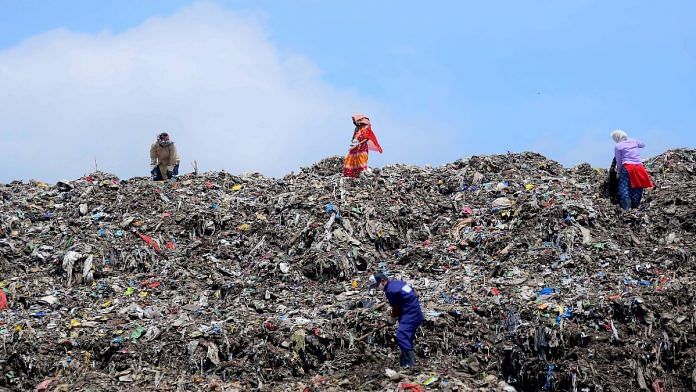New Delhi: Circularity is the answer to India’s rising industrial waste and carbon missions. The country could reuse up to 750 million tonnes (MT) of industrial waste, such as steel slag and fly ash, by 2030. It can also reduce carbon dioxide emissions by 50-90 million tonnes (MT), according to a Centre for Science and Environment (CSE) report.
“Circularity has emerged as a critical focus area globally and nationally, emphasising on the principle that waste is not merely waste, but a valuable resource,” Sunita Narain, the director general at the Centre for Science and Environment (CSE), said in a press release.
Circularity is the sustainable use of waste material from a production process by reusing it in various forms, ensuring that any economic process is circular and not linear, limiting waste production.
There has been a renewed focus in India on circularity, which Finance Minister Nirmala Sitharaman mentioned in the 2025 Budget speech. Over the last decade, Swacch Bharat Abhiyan, the 2022 ban on single-use plastic, and the E-Waste Management Rules that India passed in 2022 are all geared towards a more circular economy.
According to the CSE report, India’s material industrial consumption will likely double from seven billion tonnes in 2015 to 14.2 billion tonnes by 2030. In Europe, the quantum of goods recycled is as high as 70 percent, but the goods India recycles is a mere 20 percent. Globally, there is a big gap in overall circularity, with only 7.2 percent of the global economy being circular.
“Many Indian industries are already taking steps to improve circularity—they have a number of good practices that need to be scaled up. States like Gujarat, Goa and Karnataka have taken initiatives towards circularity, but more states need to follow their example,” Shobhit Srivastava, the industrial pollution programme manager at CSE, said in the press release.
Challenges to circularity
The CSE report comes at an opportune time. Currently, the state leaders are meeting in Jaipur for the 12th edition of the Regional 3R and Circular Economy Forum in Asia and the Pacific.
Inaugurated by Union Minister of Housing and Urban Affairs Manohar Lal Khattar, the forum focuses on global strategies and collaboration for reducing waste and promoting sustainability.
Over 500 representatives from over 20 countries in the Asia Pacific region and the United Nations will be participating in the forum, slated to pass a Jaipur Declaration on 5 March 2025, stating goals for a more resource-efficient economy.
The large-scale generation of industrial and hazardous waste, along with improper handling and mismanagement, has, in several cases, resulted in environmental accidents, such as the 1984 Bhopal Gas Tragedy. Waste poses risks to local communities, wildlife, and vegetation, with the CSE report stressing the need to shift towards a circular economy.
Circularity conserves resources—for instance, alternative fuels and raw materials derived from industrial waste, such as biomass, can reduce coal consumption in India.
Existing circular models include using fly ash from the power sector in the cement industries and reusing slag generated from the iron and steel industry for road construction.
A significant challenge in achieving circularity is the lack of regulatory push. For instance, the Ministry of Housing and Urban Affairs introduced guidelines in October 2018 on using refuse-derived fuel in different industries. However, no official notification was issued to enforce them. Without any mandatory implementation, the decision is left open-ended, with industries and other stakeholders not using RDF or ensuring its quality, according to the CSE report.
The report recommended that government and non-government bodies together process waste and re-use it while pointing out the problem of a lack of coordination between these bodies.
The report also suggested creating an inventory of industrial waste generated in the country and classifying ‘green’ products, considering circularity—whether they use recycled waste as raw material or fuel—besides their carbon emissions.
“There is an urgent need for India to have a national vision and mission towards industrial waste circularity. A national circular economy action plan is the need of the hour, and it should include sectoral action plans for industries,” Nivit K. Yadav, the industrial pollution programme director at CSE, said in the press release.
Sneha Yadav is an intern with ThePrint. She graduated from the first batch of ThePrint School of Journalism.
(Edited by Madhurita Goswami)






